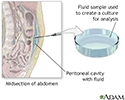Peritoneal fluid culture
Culture - peritoneal fluid
Peritoneal fluid culture is a laboratory test performed on a sample of peritoneal fluid. It is done to detect bacteria or fungi that cause infection (peritonitis).
Peritoneal fluid is the fluid in the peritoneal cavity, a space between the wall of the abdomen and the organs inside.
How the Test is Performed
A sample of peritoneal fluid is needed. This sample is obtained using a procedure called an abdominal tap (paracentesis).
A sample of fluid is sent to the laboratory for Gram stain and culture. The sample is checked to see if bacteria grows.
How to Prepare for the Test
Empty your bladder before your abdominal tap procedure.
How the Test will Feel
A small area in your lower abdomen will be cleaned with germ-killing medicine (antiseptic). You will also receive local anesthesia. You will feel pressure as the needle is inserted. If a large amount of fluid is withdrawn, you may feel dizzy or lightheaded.
Why the Test is Performed
The test is done to find out if there is an infection in the peritoneal space.
Normal Results
Peritoneal fluid is a sterile fluid, so normally no bacteria or fungi are present.
What Abnormal Results Mean
The growth of any microorganism, such as bacteria or fungi, from peritoneal fluid is abnormal and indicates peritonitis. If you have cirrhosis and bacteria are found in your peritoneal fluid, you may have spontaneous bacterial peritonitis (SBP). This is a life-threatening infection that must be treated with antibiotics.
Risks
There is a small risk of the needle puncturing the bowel, bladder, or a blood vessel in the abdomen. This may result in bowel perforation, bleeding, and infection.
Considerations
The peritoneal fluid culture may be negative, even if you have peritonitis. The diagnosis of peritonitis is based on other factors, in addition to the culture.
References
Bush LM, Levison ME. Peritonitis and intraperitoneal abscesses. In: Bennett JE, Dolin R, Blaser MJ, eds. Mandell, Douglas, and Bennett's Principles and Practice of Infectious Diseases. 9th ed. Philadelphia, PA: Elsevier; 2020:chap 74.
Solà E, Ginès P. Ascites and spontaneous bacterial peritonitis. In: Feldman M, Friedman LS, Brandt LJ, eds. Sleisenger and Fordtran's Gastrointestinal and Liver Disease. 11th ed. Philadelphia, PA: Elsevier; 2021:chap 93.
Review Date: 11/2/2022






